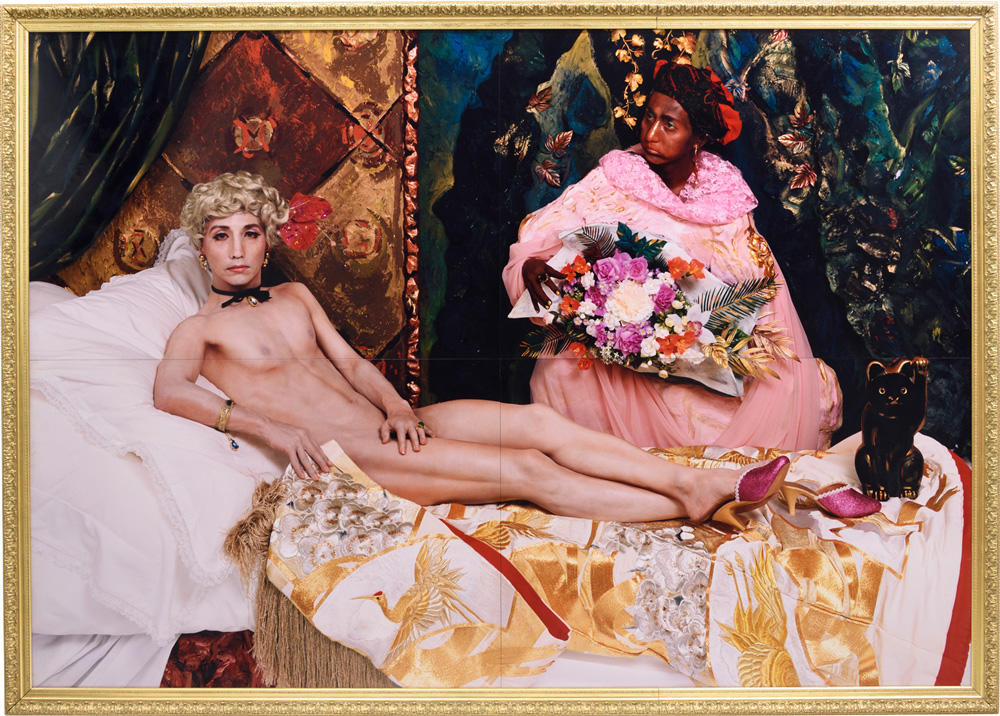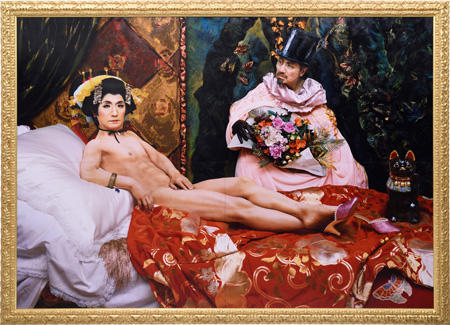Portrait (Futago)
| Artist | : | Morimura Yasumasa (1951-) |
|---|---|---|
| Nationality | : | Japan |
| Year | : | 1989 |
| Material | : | C-print, transparent medium |
| Size | : | 210 x 300 cm |
Morimura Yasumasa is known for his work in which he transforms himself into famous figures from art history, such as Portrait (Van Gogh) (1985), a photographic self-portrait where he appears as the titular artist. In the history of painting, self-portraiture developed as an introspective genre in which artists search for their own subjectivity and the inner world of the self. Wearing costumes that he creates himself, Morimura’s intrusion into major paintings of the Western canon makes him a contemporary heir to the anguish of modern Japanese artists, whereby they could only express themselves by following the norms of art as laid down by foreign cultures. At the same time, Morimura deconstructs the fixed notions of Western painting by inserting a Japanese man in various guises into these images, thus illuminating the narratives of gender and race that lurk beneath the surface. Since appearing in the Aperto section of the Venice Biennale in 1988, he has held solo exhibitions at numerous art museums in Japan and abroad.
Made thirty years apart, Morimura’s Portrait (Futago) and Une Moderne Olympia 2018 are both photographic works that deal with Manet’s famous painting Olympia (1863). By depicting a naked prostitute where the viewer would expect a nude goddess, Manet exposed the male gaze that objectifies the female body in the name of art. Flipping the issue from gender to race, Morimura places his own naked male body on the bed to represent the figure of the Oriental man who the Western gaze has frequently feminized. The figures beside the nude (respectively, a black woman and white man) are also Morimura, revealing the latent presence of white and black race relations in the mechanics of the gaze. The “self” that these self-portraits depict is not one that reflects an inner world, but rather a Japanese individual caught in a complex clash of civilizations. In this way, Morimura actively reinterprets masterpieces from art history by inserting his own body into the paintings. This critical stance is evident in Morimura’s stated aim that “by resisting the push to view history as accepted fact, I set out to destroy its authority,” and that his “artistic expressions are an extension of [...] acts of destruction and recreation.” (*)
* Morimura Yasumasa, “On My Art, My Story, My Art History” (2018), ShugoArts website, https://shugoarts.com/en/news-en/6707/ (accessed February 13, 2023).
-

Morimura YasumasaPortrait (Futago)1989C-print, transparent medium210 x 300 cm
Installation view photo: Muto ShigeoMorimura YasumasaPortrait (Futago)1989C-print, transparent medium210 x 300 cm
Installation view photo: Muto Shigeo
Portrait (Futago)
| Artist | : | Morimura Yasumasa (1951-) |
|---|---|---|
| Nationality | : | Japan |
| Year | : | 1989 |
| Material | : | C-print, transparent medium |
| Size | : | 210 x 300 cm |
Morimura Yasumasa is known for his work in which he transforms himself into famous figures from art history, such as Portrait (Van Gogh) (1985), a photographic self-portrait where he appears as the titular artist. In the history of painting, self-portraiture developed as an introspective genre in which artists search for their own subjectivity and the inner world of the self. Wearing costumes that he creates himself, Morimura’s intrusion into major paintings of the Western canon makes him a contemporary heir to the anguish of modern Japanese artists, whereby they could only express themselves by following the norms of art as laid down by foreign cultures. At the same time, Morimura deconstructs the fixed notions of Western painting by inserting a Japanese man in various guises into these images, thus illuminating the narratives of gender and race that lurk beneath the surface. Since appearing in the Aperto section of the Venice Biennale in 1988, he has held solo exhibitions at numerous art museums in Japan and abroad.
Made thirty years apart, Morimura’s Portrait (Futago) and Une Moderne Olympia 2018 are both photographic works that deal with Manet’s famous painting Olympia (1863). By depicting a naked prostitute where the viewer would expect a nude goddess, Manet exposed the male gaze that objectifies the female body in the name of art. Flipping the issue from gender to race, Morimura places his own naked male body on the bed to represent the figure of the Oriental man who the Western gaze has frequently feminized. The figures beside the nude (respectively, a black woman and white man) are also Morimura, revealing the latent presence of white and black race relations in the mechanics of the gaze. The “self” that these self-portraits depict is not one that reflects an inner world, but rather a Japanese individual caught in a complex clash of civilizations. In this way, Morimura actively reinterprets masterpieces from art history by inserting his own body into the paintings. This critical stance is evident in Morimura’s stated aim that “by resisting the push to view history as accepted fact, I set out to destroy its authority,” and that his “artistic expressions are an extension of [...] acts of destruction and recreation.” (*)
* Morimura Yasumasa, “On My Art, My Story, My Art History” (2018), ShugoArts website, https://shugoarts.com/en/news-en/6707/ (accessed February 13, 2023).





